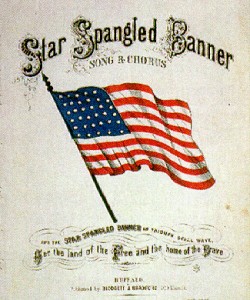 Sporting events are among the few times and places where the national anthem of the United States, the “Star-Spangled Banner” is predictably performed. In fact, if you believe this ESPN article about the history of the national anthem at sporting events, the adoption of the “Star-Spangled Banner” as a baseball tradition preceded and perhaps contributed to it becoming the official national anthem in 1931. The anthem and sports have had their highs and lows together, both literally and figuratively. This supports Dear Sports Fan’s proposition that sports are so ingrained in our society that they are worth understanding and enjoying if possible.
Sporting events are among the few times and places where the national anthem of the United States, the “Star-Spangled Banner” is predictably performed. In fact, if you believe this ESPN article about the history of the national anthem at sporting events, the adoption of the “Star-Spangled Banner” as a baseball tradition preceded and perhaps contributed to it becoming the official national anthem in 1931. The anthem and sports have had their highs and lows together, both literally and figuratively. This supports Dear Sports Fan’s proposition that sports are so ingrained in our society that they are worth understanding and enjoying if possible.
Juxtaposing the anthem with a sporting event often leads to interesting customs, not all of them completely dignified. Almost every audience I’ve ever heard begins cheering before the song is over, as if to say, “let’s get this anthem business over and get to the real event!” The Chicago Blackhawks fans stand and cheer throughout the entire song. The Baltimore Orioles fans holler “O” along with the “Oh say does that star-spangled banner yet wave”. And of course, there are plenty of anthem singers who mess up in almost every way imaginable.
Rueben Fischer-Baum of deadspin.com (no relation that I’m aware of) recently did a study that attempted to discover where the most treacherous parts of the song were for anthem singers at sporting events. Writes Fischer-Baum:
The danger zone seems to be a pair of lines in the middle: O’er the ramparts we watched / Were so gallantly streaming? These lines are tough for a few reasons. First, as everyone learns in Intro Psych, it’s harder to remember stuff that’s in the middle of a sequence than it is to remember stuff at the beginning or end. Second, the structure of this whole section is poetically jumbled (easier to understand: “Whose broad stripes and bright stars / were so gallantly streaming / through the perilous fight / o’er the ramparts we watched?”)
It’s not really our style at Dear Sports Fan to post cringe-worthy videos of people messing up in public, but this one of Natalie Gilbert is a famous and heartwarming one because of how former basketball player and then coach of the 76ers, Mo Cheeks, comes to the rescue of the young singer.
As Fischer-Baum also mentions, the tune itself is notoriously difficult to sing. The Star-Spangled Banner is set to the tune of “a popular British song written by John Stafford Smith for the Anacreontic Society,” a “popular gentlemen’s club of amateur musicians.” How difficult is it? Difficult enough that a few years back it made the New York Times Magazine‘s now sadly defunct “Year in Ideas“. The idea was that lowering the official key of the tune to create a “singable national anthem” could have a positive effect on our entire culture as it pertains to singing.
”The Star Spangled Banner” has contributed to a nationwide decrease in singing, because Americans are routinely embarrassed by how badly they sound hollering it out. “This has caused a form of post-traumatic stress disorder in our culture,” [Ed Siegel] says. “People freak when asked to sing.”
Of course, changing the song’s key doesn’t fix its absurdly wide range, and the new lows will be too low for some. ”People can mumble those parts if necessary,” Siegel says. ”But everyone should be able to hit the high notes — that’s where it gets exciting.”
The anthem can be exciting indeed when it is sung by master musicians, and there is a tradition of popular singers taking the anthem before a sporting event and making it their own. The aforementioned ESPN article about the anthem reminds us that “Whitney Houston’s rendition before Super Bowl XXV in 1991 has been a top-20 single not once but twice: first in 1991 during the Gulf War and again in 2001 after the 9/11 attacks.” Grantland had an entire feature article about Marvin Gaye’s famous anthem before the 1983 NBA All-Star Game. Gaye took such a nontraditional approach to the anthem that as soon as the beat dropped, the Lakers’ public address man, Lawrence Tanter, thought, “Ah, shit, man, they’ve got the wrong tape. This is ‘Sexual Healing’.” NPR remembered the performance on its twentieth anniversary and credited Gaye for having opened up the pregame national anthem as a vehicle for musical statements instead of simply a straight-ahead, nationalistic, musical requirement.
Sometimes though, the straight ahead way is the best of all, like at the first Boston Bruins game after the Boston Marathon bombing. Despite all of its faults, it’s a pretty nice song.

